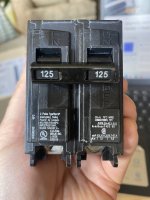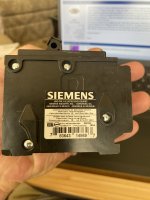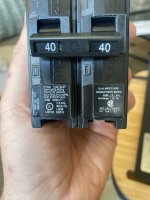The AIC rating will effect the pricing considerably.
Electrical Circuit Breakers
"Ampere Interrupting Capacity (AIC)
Circuit breakers are tested and then rated as to their ability to open the protected circuit with a specific amount of current flowing in the circuit. Circuit breakers typically have AIC ratings of between 5,000 and 200,000 AIC. The amount of fault current available must not exceed the breaker’s ability to safely open the circuit. Not only must the breaker be rated for the applied voltage, and continuous amperage load; it must also have an AIC rating equal to or greater than the available current at the location in the circuit where it will be installed. Breakers that have been installed so that the available fault current exceeds its AIC rating may blow up, just like a bomb would explode were it to attempt to clear a fault current above its rating. When opening a faulted circuit, it is possible for smoke and fire to be exhausted from a breaker. If you would like to see a breaker belch fire and smoke, see if you can locate and view the Cooper-Bussmann fuse company videotape titled “Specification Grade Protection”. The visual impact of this tape will likely enhance your appreciation of the importance of an electrical device’s AIC rating far better than any words of mine.
In your safety classes, you likely have received training in the step to the side routine before manually switching electrical circuits, and this videotape will reinforce the value of this easy safety step. This is also a good reason why sheet metal covers called dead front trim should be re-installed on loadcenters, panelboards, and the like before operating switching devices.
Electrical engineers tell us that the two major factors that govern the amount of fault current that can be delivered in a system are the KVA rating of the transformer and the impedance of the transformer. The presence of connected electric motors in the circuit also adds to the amount of potential fault current. Considering 480 volt systems, combined transformer and motor fault currents can range from 14,400 amps for a 500 KVA transformer with an impedance of 5.0% to some 90,000 amps for a 3500 KVA transformer with 5.75% impedance. Selecting all circuit breakers for higher AIC ratings may be the safety first and cost last method."
Edited to add; my meterbase is a 200 amp Siemens using a 22KA 200 Amp breaker



